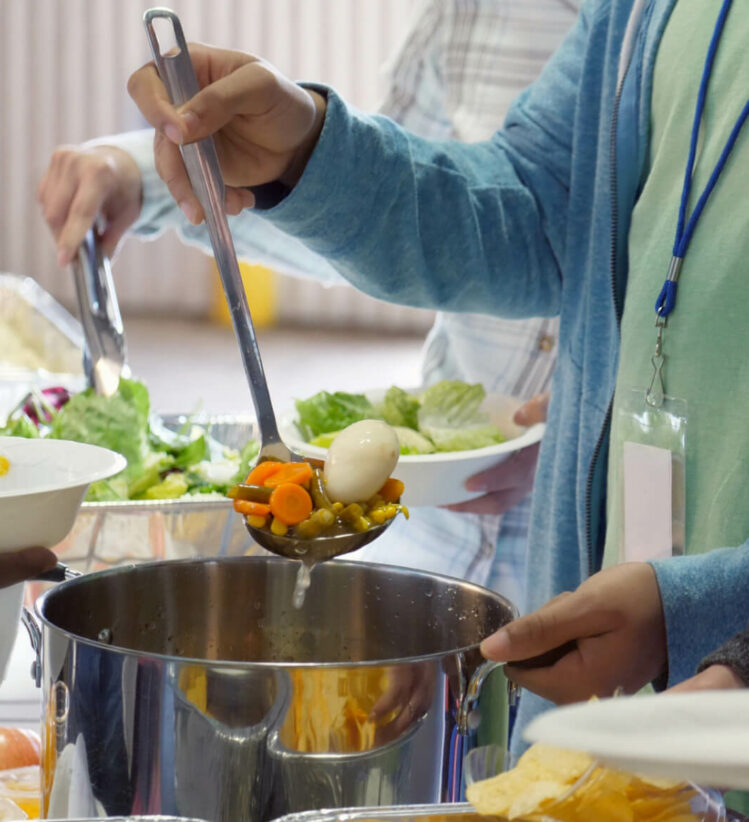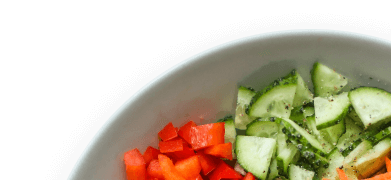Working with food outlets
Working with retail outlets to make healthy changes to the foods and drinks they offer doesn’t need to be difficult.
Use the information below to help you work with retailers that provide meals, snacks and drinks for staff and visitors in your organisation.

01 - What are the guidelines for healthy food retail outlets?
For retail outlets, the Healthy Choices guidelines recommend that:
- at least 50% of the foods and drinks provided are from the GREEN (best choices) category
- GREEN choices are always available and promoted and are displayed prominently
- no more than 20% of the foods and drinks provided are from the RED (limit) category
- RED choices are not promoted or displayed prominently.
- RED choices (like sugary drinks, confectionery or deep fried foods) should not be supersized, and should not be included in specials like meal deals or ‘two for one’ offers.
02 - Types of food outlets
Many types of retail outlets provide meals, snacks and drinks for an organisation, so the first thing you need to do is think about the type of outlet you will be working with, for example:
- canteens
- kiosks
- cafes
- cafeterias
- food trucks
- coffee shops or coffee carts
Some retail outlets stock mostly packaged products (e.g. kiosk) and some make most of their foods and drinks on-site (e.g. café).
Having a good understanding of the type of outlet you are working with, and the way the outlet operates, will help you work with the outlet to make healthy changes.
03 - Understanding contracts with retailers
If your organisation holds a contract with a retail outlet you will need to understand the conditions of the contract and work together with the retailer to make any healthy changes needed.
You will need to find out:
- who manages the outlet
- the terms of the contract
- whether the contract includes requirements for providing healthy foods and drinks
- when the contract expires
Having this information will help you negotiate with the retailer and will help you work out whether you can switch to a new retail provider if needed.
04 - Working with on-site retailers
If you have a contract with an on-site retail outlet, you can include a service agreement in the contract which states that the outlet needs to meet the Healthy Choices guidelines. This will help make sure your efforts in providing healthier choices are sustainable and embedded across your organisation.
This is easily achieved if your current contract can be changed or is about to be renewed, or if you are getting a new retail provider.
If you have a contract with an outlet that cannot be changed and is not up for renewal, you should encourage the outlet to make healthy changes before the contract expires.
If you are working with an on-site retail outlet, but there is no formal contract in place, this is an excellent opportunity to sign a new contract which includes requirements for providing healthy foods and drinks.
If your organisation is putting out a tender for a new outlet, make sure that requirements for providing healthy foods and drinks are included in the tender specifications.
05 - Working with off-site retailers
Even if a retail outlet is located off-site (i.e. outside your organisation), and there is no formal contract in place, you can still encourage the outlet to implement the Healthy Choices guidelines.
You can:
- discuss the benefits of providing healthy foods and drinks – for the outlet and for customers
- present case studies of other businesses who have successfully made healthy changes
- survey staff and visitors about healthy foods and drinks they would like to purchase from the outlet
- encourage staff and visitors to ask for healthier options from the outlet.
You can find out how the food and drinks offered in a retail food outlet are classified under the Healthy Choices guidelines, with a free online menu assessment.
To plan a healthy menu for each day of the week, first classify your food and drink items online using FoodChecker. Then use our rotational menu planner (Excel spreadsheet) to ensure you provide the correct percentage of GREEN, AMBER and RED foods and drinks on the menu each day.
Simply add each item and its classification to the planner, then plan each day’s menu in line with the Healthy Choices guidelines.
07 - Healthy food and drink ideas
Retail outlets looking for healthy meal, snack and drink ideas can be referred to:
08 - Promote your healthy options
If you are making changes towards meeting the Healthy Choices guidelines, you might be eligible to display the Healthy Choices signage. Contact us to find out more.
Healthier food outlet benefits
Benefits for the organisation
Communicate healthy lifestyle messages
Having a healthier food outlet in your organisation will help you promote messages about healthy eating and wellbeing to your community.
If your organisation’s core business is related to health (e.g. recreation centres), having a healthy food service supports the organisation’s culture and will help you meet community expectations about encouraging healthy lifestyles.
A healthy food service also helps to create a family friendly environment that encourages community engagement.
Position your organisation as an industry leader
By making healthy changes, your organisation can be a leader in promoting good health, and can encourage change in the system by increasing the demand for healthier choices.
Benefits for the food outlet
Enhance your market position
Offering healthy meals, snacks and drinks can help retailers secure a contract with your organisation, as well as other organisations who want to provide healthy foods and drinks for their staff and visitors.
In addition, organisations registered with the Achievement Program are more likely to use healthy retail outlets when purchasing catering for meetings, conferences and other events.

Increase your revenue
A healthy menu can attract new customers who are more health conscious, and even smaller portion sizes can help bring new business.
For example, at Alf’s café (Alfred Health), when mini meal portions were introduced they were very popular and new customers started buying these from the café.
Enhance innovation
Making healthy changes is not only about replacing unhealthy options – it’s about having the opportunity to create and innovate. Food outlets may like to consider expanding their existing menus or creating new meals and snacks, and this is likely to keep consumers interested and coming back for more.
Healthy changes are simple!
A change for the better does not need to be complicated, and the way changes are made can be adapted for individual organisations.
Changes don’t need to happen all at once, and a phased approach is often the best way to go.
Remember, even simple changes can have a big impact!
To receive this document in an accessible format phone 1300 22 52 88 or email heas@nnf.org.au
Except where otherwise indicated, the images in this document show models and illustrative settings only, and do not necessarily depict actual services, facilities or recipients of services. This document may contain images of deceased Aboriginal and Torres Strait Islander peoples. In this document, ‘Aboriginal’ refers to both Aboriginal and Torres Strait Islander people. ‘Indigenous’ or ‘Koori/Koorie’ is retained when part of the title of a report, program or quotation. Copyright © State of Victoria 2016

For more information please phone 1300 22 52 88 or email heas@nnf.org.au
Except where otherwise indicated, the images in this document show models and illustrative settings only, and do not necessarily depict actual services, facilities or recipients of services. This document may contain images of deceased Aboriginal and Torres Strait Islander peoples. In this document, ‘Aboriginal’ refers to both Aboriginal and Torres Strait Islander people. ‘Indigenous’ or ‘Koori/Koorie’ is retained when part of the title of a report, program or quotation. Copyright © State of Victoria 2016
Written and reviewed by dietitians and nutritionists at National Nutrition Foundation, with support from the Victorian Government.

Featured recipes
Explore all recipesRegister your interest
"*" indicates required fields














